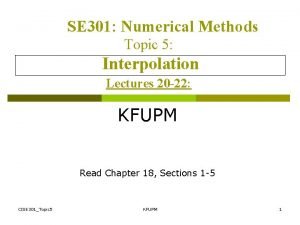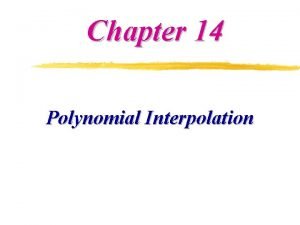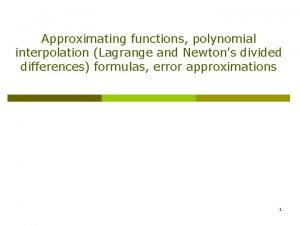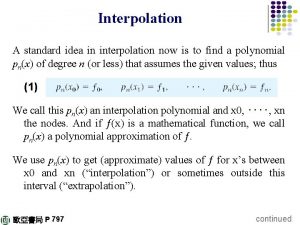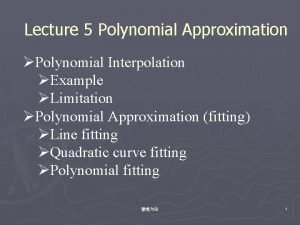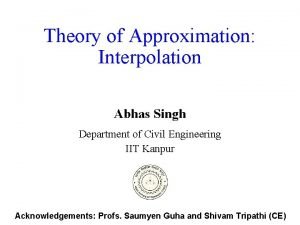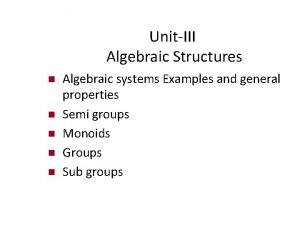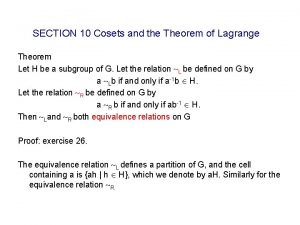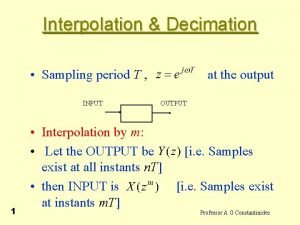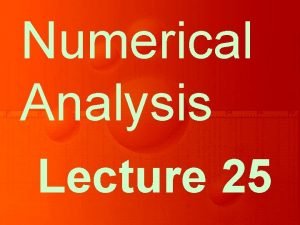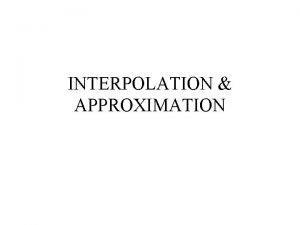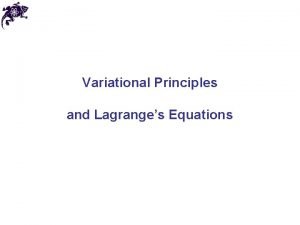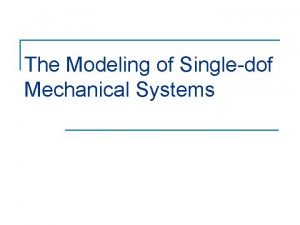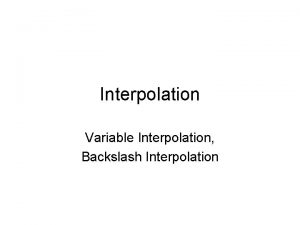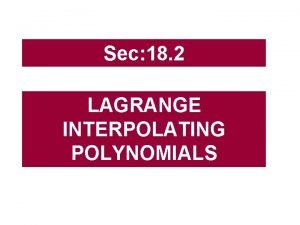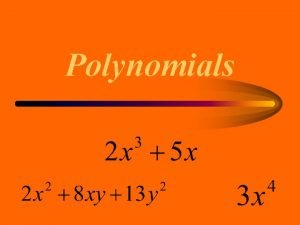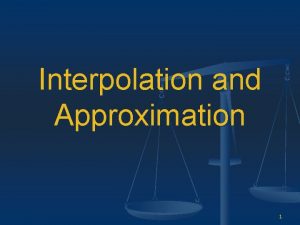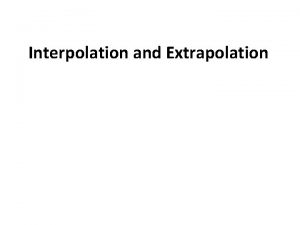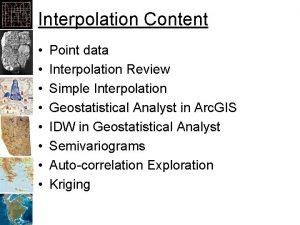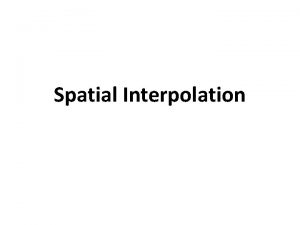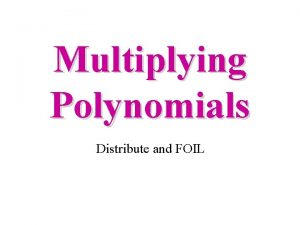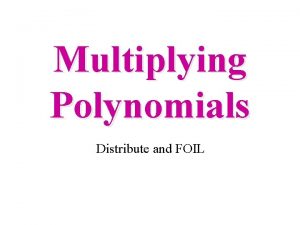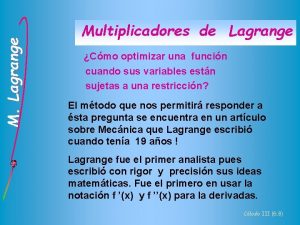Sec 3 1 Interpolation and the Lagrange Polynomials














- Slides: 14

Sec: 3. 1 Interpolation and the Lagrange Polynomials

Sec: 3. 1 Interpolation and the Lagrange Polynomials Find a polynomial that passes through these n+1 points . . .

Sec: 3. 1 Interpolation and the Lagrange Polynomials Consider the following polynomial deg poly ? L(1) = L(2) = L(9) = L(8) = L(5) = Define: Difference ? Lagrange interpolating polynomial

Sec: 3. 1 Interpolation and the Lagrange Polynomials Consider 1 2 3 200 500 900 Lagrange interpolating polynomial

Sec: 3. 1 Interpolation and the Lagrange Polynomials Lagrange interpolating polynomial Given the set of data Realize that each term Ln, k (x) will be 1 at x = xk and 0 at all other sample points

Sec: 3. 1 Interpolation and the Lagrange Polynomials Lagrange interpolating polynomial Given the set of data Realize that each term Ln, k (x) will be 1 at x = xk and 0 at all other sample points

Sec: 3. 1 Interpolation and the Lagrange Polynomials Given the set of data Theorem 3. 2 If x 0, x 1, . . . , xn are n + 1 distinct numbers and f is a function whose values are given at these numbers, then a unique polynomial p(x) of degree at most n exists with f (xk) = p(xk), for each k = 0, 1, . . . , n. This polynomial is given by Remark

Sec: 3. 1 Interpolation and the Lagrange Polynomials Example Given the data Estimate f (4) using Lagrange interpolating polynomials of order 3.

Sec: 3. 1 Interpolation and the Lagrange Polynomials Exam 1 Term 171 clear; clc p 2 = @(x) (x-2. 75). *(x-4)/(4*0. 75). . . +(x-2). *(x-4)/(-2. 75*0. 75*1. 25). . . +(x-2). *(x-2. 75)/(4*2*1. 25); f = @(x) 1. /x; x=2: 0. 1: 4; fx=f(x); p 2 x=p 2(x); plot(x, fx, 'r-', x, p 2 x, 'k-'); grid on

Sec: 3. 1 Interpolation and the Lagrange Polynomials

Sec: 3. 1 Interpolation and the Lagrange Polynomials Example Given the data Estimate f (4) using Lagrange interpolating polynomials of order 3. x=[1 2 3 5] y=[-8 6 16 48] a =4 n = length(x); sum = 0; for i=1: n product = y(i); for j=1: n if (i~= j) ; product = product*(a-x(j))/(x(i)-x(j)); end sum = sum + product; end ya = sum x= 1 2 3 5 y= -8 6 16 48 a= 4 ya = 28

Sec: 3. 1 Interpolation and the Lagrange Polynomials Example Given the data Estimate f (4) using Lagrange interpolating polynomials of order 3. function [ya] = langrange(x, y, a) n = length(x); sum = 0; for i=1: n product = y(i); for j=1: n if (i~= j) ; product = product*(a-x(j))/(x(i)-x(j)); end sum = sum + product; end ya = sum; end FUNCTION in MATLAB A function is a group of statements that together perform a task. In MATLAB, functions are defined in separate files. The name of the file and of the function should be the same. Functions operate on variables within their own workspace, which is also called the local workspace, separate from the workspace you access at the MATLAB command prompt which is called the base workspace. p=[1 2 3 5] q=[-8 6 16 48] z=4 [yz] = langrange(p, q, z)

Sec: 3. 1 Interpolation and the Lagrange Polynomials bound for the error Where is the maximum error? Note that the error form for the Lagrange polynomial is quite similar to that for the Taylor polynomial.

Sec: 3. 1 Interpolation and the Lagrange Polynomials Errors of Lagrange Interpolating Poly Determine the error form for this polynomial, and the maximum error
 Lagrange's interpolation formula
Lagrange's interpolation formula Interpolation quadratic
Interpolation quadratic Lagrange method interpolation
Lagrange method interpolation Secret sharing lagrange interpolation
Secret sharing lagrange interpolation Lagrange's interpolation formula
Lagrange's interpolation formula Spline interpolation vs polynomial interpolation
Spline interpolation vs polynomial interpolation Abhas singh iitk
Abhas singh iitk Lagrange, euler, and kovalevskaya tops
Lagrange, euler, and kovalevskaya tops Lagrange's theorem formula
Lagrange's theorem formula State and prove lagrange's theorem
State and prove lagrange's theorem Interpolation and decimation
Interpolation and decimation Newton's divided difference
Newton's divided difference Interpolation and approximation of curves in cad
Interpolation and approximation of curves in cad Joseph-louis lagrange
Joseph-louis lagrange Lagrance
Lagrance
